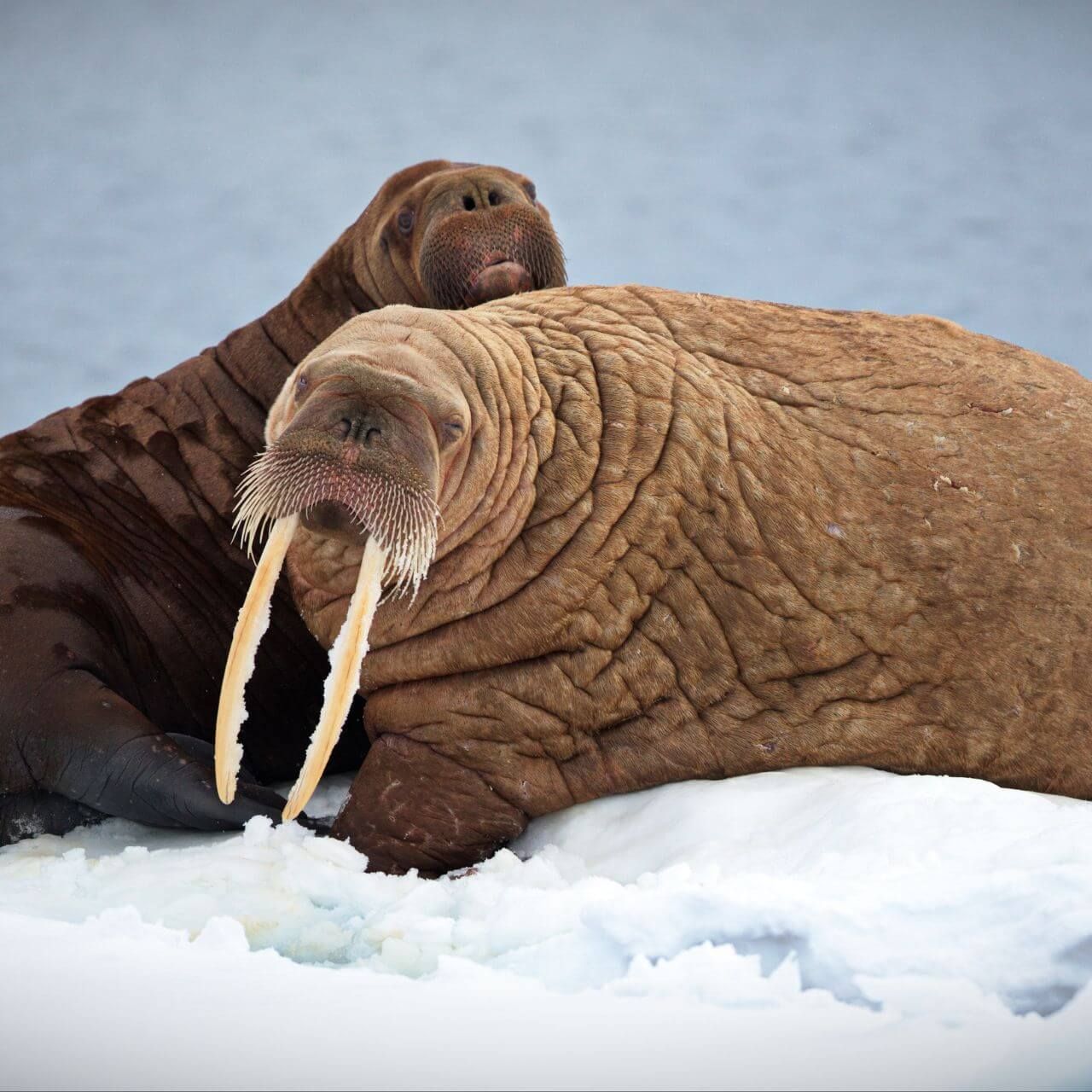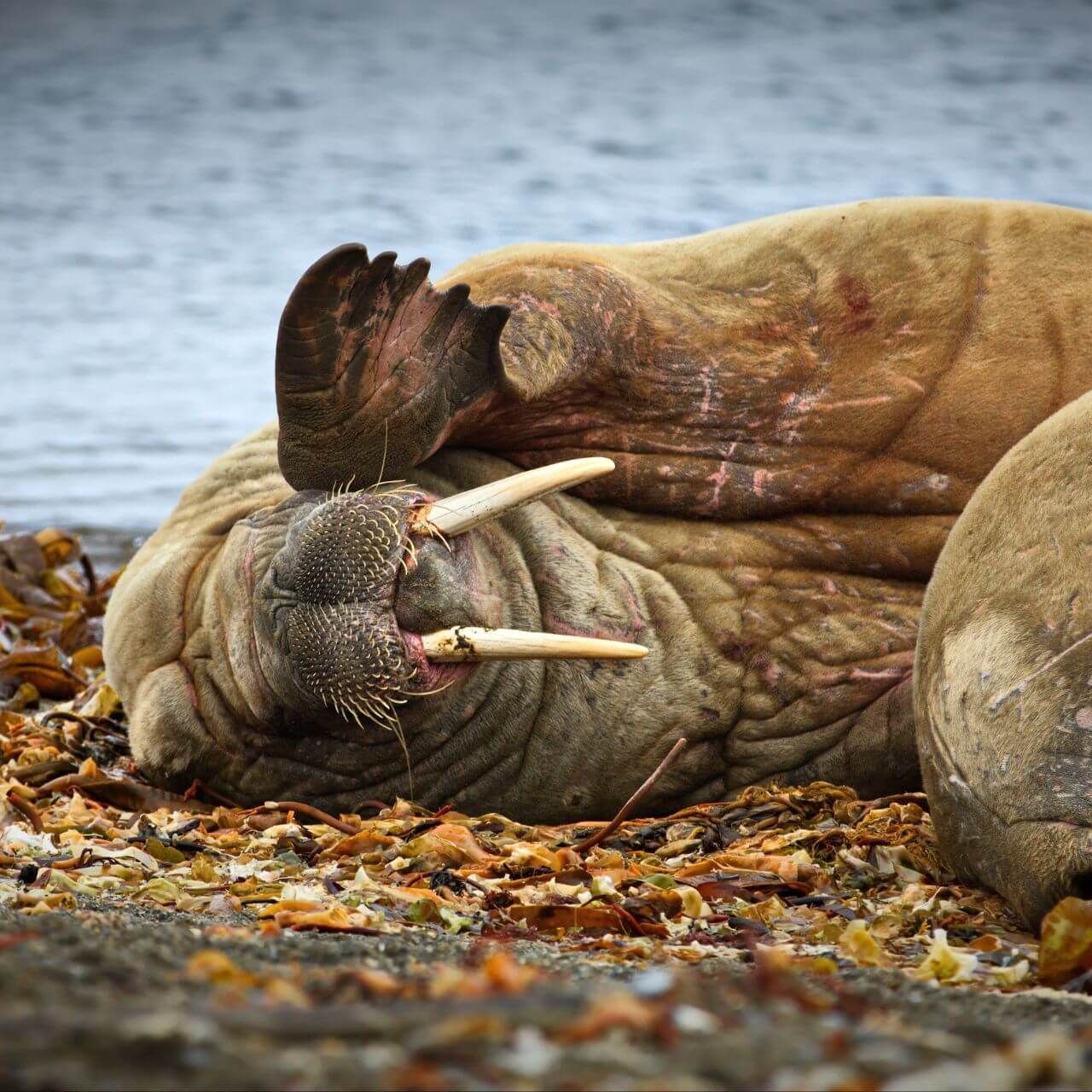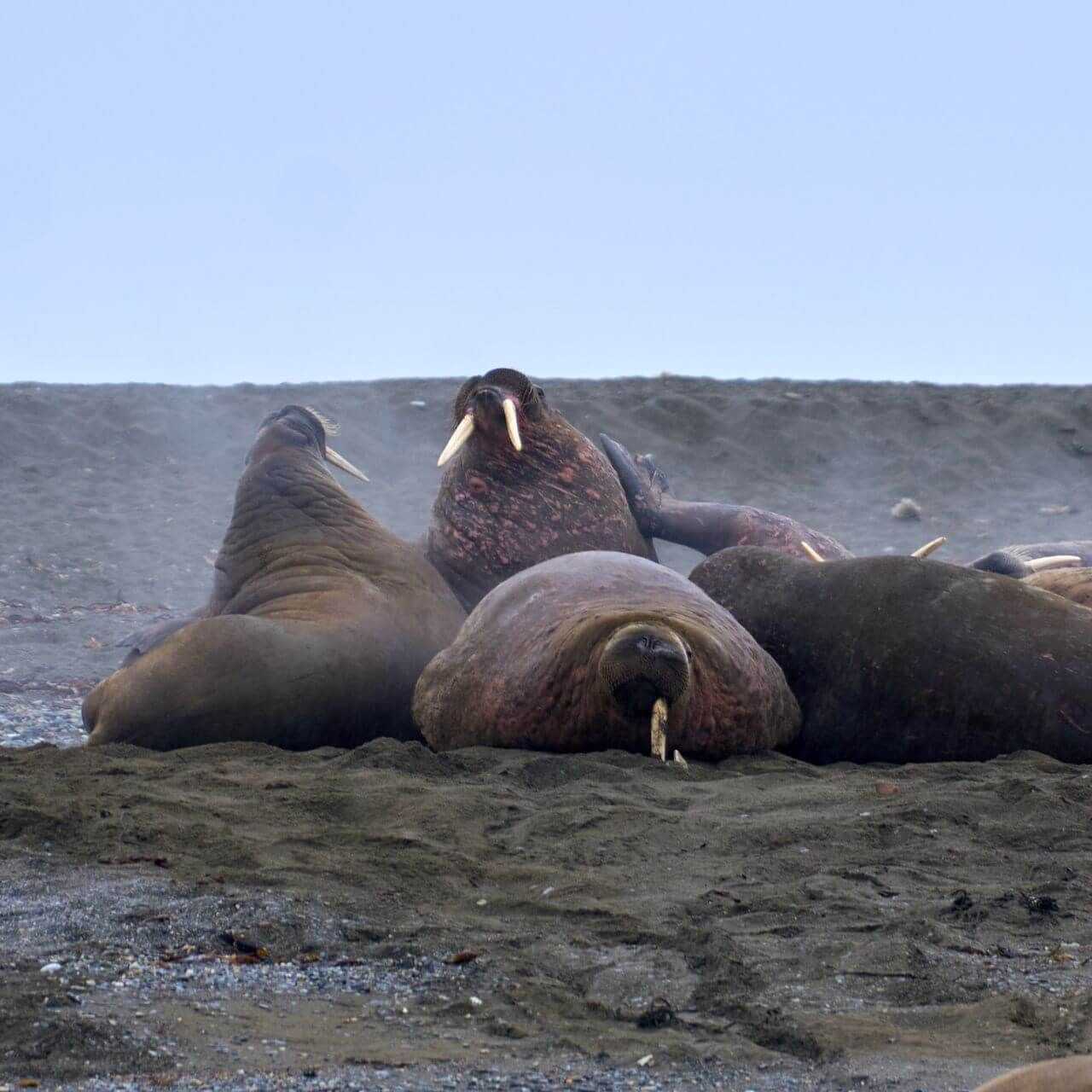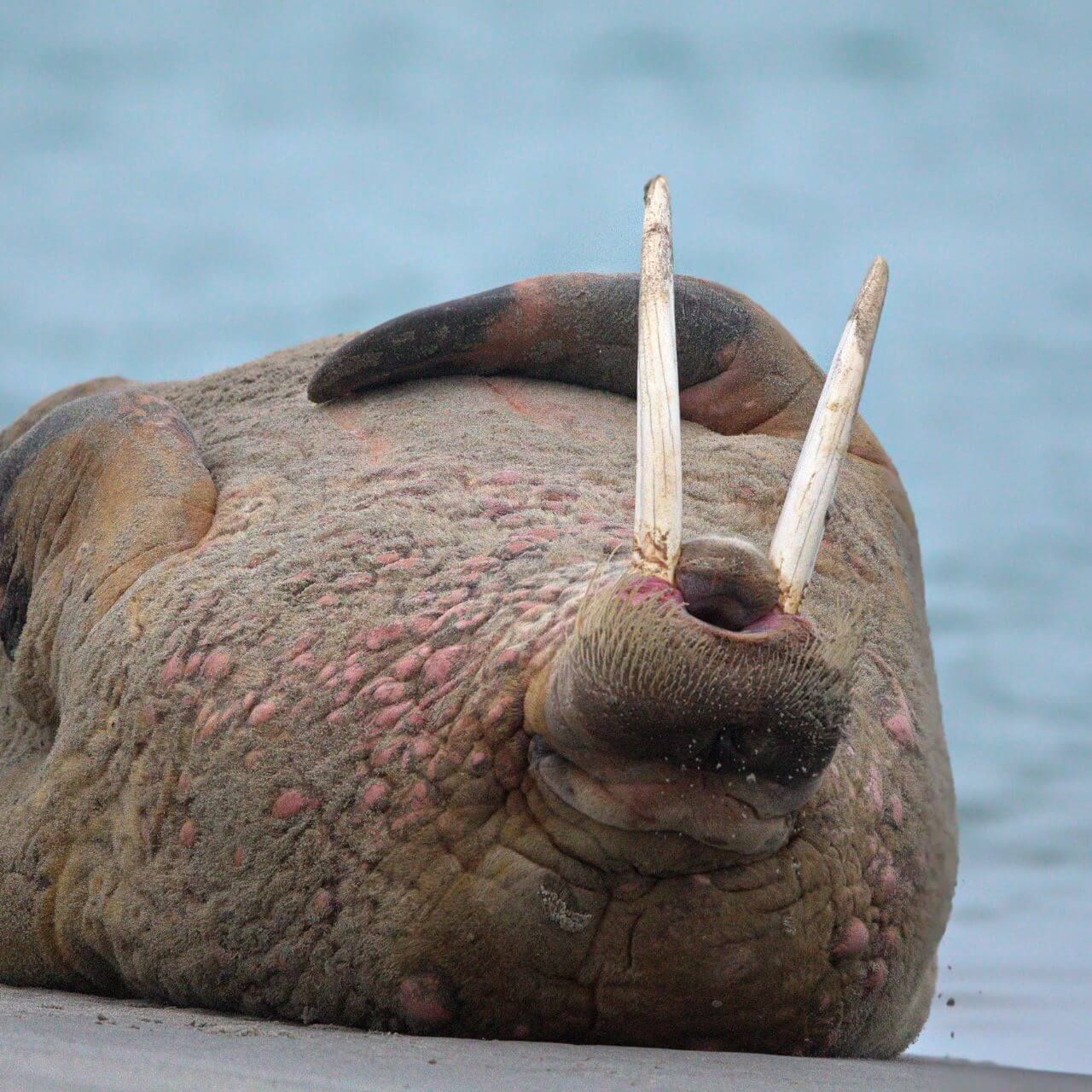Walruses

Let's Learn About Walruses
Word of the Week
Blubber
Blubber is a thick layer of fat. It traps heat inside an animal's body, so many animals use it to stay warm.
Polar bears, whales, walruses, and other pinnipeds have blubber. A walrus's blubber can be more than 6 inches thick.
Fast Facts

Where do walruses live?
Walruses live in the Arctic Circle near the North Pole. They are found around the Pacific Ocean and Atlantic Ocean.
Walruses use the ocean for hunting and traveling and coastlines and sea ice for resting.
What do walruses eat?
Walruses are carnivores.
Clams and mussels make up most of their diet. They also eat shrimp, crabs, worms, sea cucumbers, and other slow-moving animals.


What traits do walruses have?
Walruses are a single species of pinniped known for their...
- Powerful flippers.
- Enormous social groups.
- Long, sharp tusks.
- Sensitive whiskers.
How many walruses are there?
Scientists estimate there are more than 100,000 walruses in the Arctic Circle.
They are listed as vulnerable to extinction because of threats like climate change and poaching for their meat, blubber, and tusks.

Species Spotlight
Walruses: A Keystone Species
To understand keystone species, we must talk about keystones. In a bridge, the middle stone that supports the bridge is called the keystone. If the keystone is removed, the bridge will collapse.
Similarly, a keystone species is a plant or animal that is so important that, if removed, its environment would collapse.
Walruses are a keystone species because they mix nutrients into the water when feeding. They stir up sand with their powerful flippers to uncover prey. Nutrients and small organisms trapped in the sand mix into the water. These released nutrients help algae, especially phytoplankton, grow.
Phytoplankton are then eaten by small animals, which are eaten by larger animals, and so on! The ocean food web would collapse without walruses stirring nutrients into the water for the phytoplankton.
Walruses are also important because they control the population of clams and mussels. Walruses eat thousands of them in a single meal. The remaining clams and mussels have more space and resources to grow and survive.
Unfortunately, walruses are vulnerable to extinction due to threats like climate change. If walruses become extinct, the entire Arctic Ocean ecosystem is at risk. Keep reading to learn how you can protect walruses in the Conservation Corner.
BRAIN BLAST
Predict what would happen to the ocean ecosystem if walruses went extinct?
Conservation Corner
The Affect of Climate Change on the Arctic
What Is Climate Change?
Climate change is the change of weather patterns around the world due to greenhouse gases.
What Are Greenhouse Gases?
Greenhouse gases are gases that trap heat near the Earth’s surface. These gases are made when burning fossil fuels (coal, oil, etc.) to make usable energy, like electricity.
----
Climate change affects different parts of the world in different ways. Deserts are becoming drier while the tropics are having larger, more frequent storms. Climate change is causing many areas, such as the Arctic, to warm.
In the Arctic, thousands of miles of sea ice form in the winter. Then, as summer arrives, most of the winter ice melts. Animals like polar bears, seals, and walruses rely on the pattern of forming and melting sea ice to rest, feed, and have their offspring.
As the Arctic warms, the sea ice takes longer to form in the winter. It also melts faster in the summer. Sea ice that used to stay frozen all summer has started to disappear. Scientists worry that the population size of Arctic animals will continue to shrink if we don’t stop climate change.
Luckily, we can help! The best way to stop climate change is to stop making greenhouse gases. We can do that by using less energy. Turn off electronics and avoid buying new products (it takes energy to make them!). Instead, buy already-loved items or trade with your friends. You can also encourage your local community to switch to renewable energy. Learn more here!
The Many Tasks of Tusks
Identify what walruses use their tusks for by marking "yes" or "no" for each task.
Walrus Challenge
Describing Walrus Traits
Beginner
Write a word that describes walruses for each letter of the word "walrus." Discuss as a group how each word describes walruses.
On page 2, draw and color a walrus eating its favorite food - clams!
Expert
Write a word that describes walruses for each letter of the word "walrus." On page 2, write two sentences explaining how each word describes walruses.
On page 3, draw and color a walrus eating its favorite food - clams!
Learn More!
Glossary
Adaptation
The process by which a species becomes more fit for its environment over the course of several generations. It is a result of natural selection.
Arctic Circle
The area around the North Pole.
Blubber
A layer of fat that helps animals like walruses, whales, and polar bears stay warm.
Carnivore
An animal that eats other animals.
Climate Change
A change in global weather patterns as a result of greenhouse gases in the atmosphere.
Dominant
To be the most powerful animal in the group.
Endangered
Referring to an organism that is threatened with extinction.
Food Web
A tool used by scientists to show how food chains overlap and the different pathways of energy transfer.
Keystone Species
A species whose presence has an unusually high impact on the ecosystem relative to its population size.
Nutrients
Substances that plants and animals need to grow and remain healthy.
Phytoplankton
Microscopic algae that float near the surface of aquatic (water) ecosystems.
Pinniped
The group of mammals with seals, sea lions, and walruses.
Poaching
The illegal act of hunting or capturing an animal.
Predator
An animal that hunts other animals for food.
Prey
An animal that is hunted and eaten by another animal.
Semi-Aquatic
Spending some time on land and some time in water.
Species
A closely related group of animals with similar characteristics that are capable of reproducing (example: gray wolf).
Subspecies
A group within a species that is genetically different from other groups in the same species (example: there are many subspecies of gray wolf, like the Mexican wolf and Arctic wolf).
Tusk
A large tooth that typically sticks out of an animal's mouth.
Vibrissae
Sensory hairs growing around the mouth of many mammals (also known as whiskers).
Sign Up for our Newsletter
Stay up to date with new adventures, live classes, deals, and more!

Helpful Resources
*Please note we do not offer refunds for EdZOOcating Adventures memberships. We recommend you explore the 3-day free trial prior to subscribing!*


